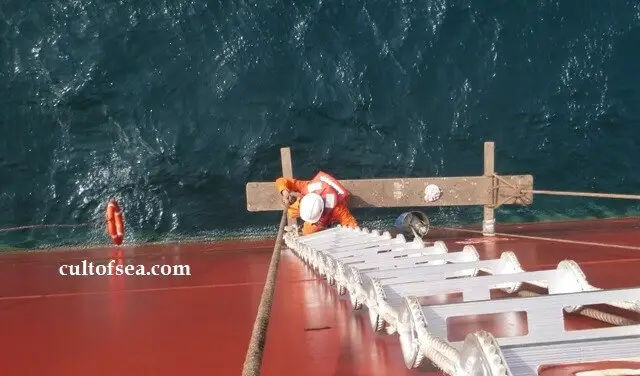Definition
Working aloft or Overside means a work being performed at a height and involving risk of falling, resulting in an injury.
Guidelines
As a general rule, personnel should not be permitted to work overside when the vessel is underway unless it is absolutely necessary and as determined by the Master.
- Personnel under training shall not be assigned aloft or over side related jobs.
- The power source to potential hazards such as ships whistle, radar, etc. should be isolated from their power source and accidental activation prevented by the use of warning signs and / or removal of fuses.
- The area below the workspace should be, as far as possible cordoned off to prevent injury to passerby due to falling debris / accidental dropping of objects.
- Equipment to be used by the personnel working aloft or over side should be securely housed in tool belts / bags. Tools / equipment that cannot be carried on a person should be hoisted to the place of work in secure containers.
- Staging/scaffoldings rigged should be inspected for any potentially dangerous defects. Only equipment and ropes in good order should be used. Ladders must be safely secured against slippage. Securing points should be of adequate strength.
- Personal protection gear such as work harnesses, helmets, goggles, gloves appropriate to the job being executed should be used by personnel involved in working aloft / over side.
- Upon completion of the jobs, all equipment must be removed from the site and warning notices / isolated systems restored to normal condition.
Concerned personnel must be notified of completion of the job.
Validity
The Permit should contain a clear indication as to its maximum period of validity. (Usually, shall not exceed one day /24 Hours).
Working Aloft or Overside is considered to be a Critical Operation.
Hazards Involved
- Falling from a height or in the water when working overside or on ships deck.
- Personal Injury whilst working on the Mast.
- Personal injury by falling objects.
- Fines/ Protests incurred due to non-compliance with Port Regulations
Control Measures to be taken while working Aloft or Overside
- Proper PPE shall be donned at all times.
- All equipment and ropes to be used for the job shall be thoroughly inspected.( Stages, Ropes used for fixing staging, ropes used as lifelines, Safety Harness, Work Vests, Lines used for securing tools and the Ladder).
- Adequate non-skid shoes to be worn.
- Ensure area is clear of any slipping hazard.
- Harness and lifeline to be used at all times.
- Lifebuoy to be kept ready.
- Rescue boat shall be ready for immediate deployment.
- All concerned personnel to be informed.
- Safety Line connected to the safety harness must have only sufficient slack to allow for free movement of the personnel.
- Weather / Vessels condition should be suitable for work.
- Safety nets to be rigged were applicable.
- Company-specific Working Aloft checklist to be complied with.
- Follow safe practices as per COSWP.
- Electrical connections shall be isolated prior to commencing work on electrical components and EIC to be issued.
- Display notices/ placards prohibiting the operation shall be placed at all controls of Ships whistle, Radars, MH/HF device as applicable.
- Sufficient personnel to attend the person working aloft at all times.
- Whilst lowering any objects, safety lines/ buckets to be used.
- Prior lowering any objects, ensure that all personnel in space are clear underneath.
- If Painting is to be carried out within the jurisdiction of any port, approval must first be sought from the port Authorities.

is washing down from a fender hook allowed or are longitudinal tracks required for over the side works now?